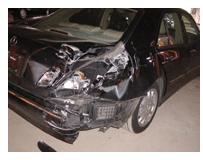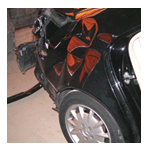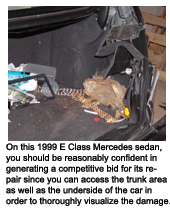When an insurance adjuster comes into your shop and makes the statement that he “has shops that will do the job” for the price he’s trying to convince you to work for, ask him this: Which shop has actually seen this car? Who’s the contact person at that shop?
Chances are good the adjuster can’t furnish the name of the shop or the person with whom he negotiated an agreed price – because one doesn’t exist. It’s likely conjecture on his part.
The collision repair industry, however, has come to accept this mode of, shall we say, chicanery, as the way claims are settled. Repairers oftentimes become sidetracked with dissecting the methodology, labor databases and other functions of the insurance industry, while ignoring the real problem – body shops succumbing to the insurance claims game in their individual markets.
What has happened without some of us realizing it is that we’ve been competing with insurance companies and their lower-priced “phantom” shops, as opposed to actual shops that have entered a competitive bid.
How do we stop this insanity, you ask? With the adoption of a competitive bidding process to establish repair costs.
Writing ‘Fixed’ Bids
This competitive bidding process isn’t entirely unfamiliar to the industry, as the old timers among us will tell you. Once upon a time, your customers were told to secure three estimates from area shops, from which the insurance company selected and paid the lowest of the three. While this process was inherently unfair and subject to manipulation on a massive scale (who among us didn’t have blank estimates from a competitor?), it nevertheless represented a much more competitive process for determining the actual cost of repairs than what we have today.
What needs to happen is for shops to insist upon competing with other capable providers in their marketplace. This is a major departure from the present form of claims settlement that most of you grew up with and have learned to accept as the way things have to be done. The problem with this line of thinking – as I see it, anyway – is that the providers of the service (that’s you) have allowed the payers to set prices.
How do you escape the business-as-usual method of settling claims with insurance companies? To be honest, it doesn’t come about without some degree of boldness, but I think it’s well worth a try.
The next time you have a customer’s car in your shop that’s insured by a second- or third-tier insurance company (they’re a little easier to leverage), write your estimate as if it were a fixed bid – no supplements. That is, no supplements will be allowed for anything that was not foreseeable. This can be accomplished by any seasoned estimator with substantial industry experience. Of course, a teardown will be required to establish a firm bid on repair costs, which can be authorized by your customer once you’ve sold the job and have the keys.
The authority on repairs and the repair process belongs solely to your customer: the car owner. In fact, this authority is acknowledged in the boilerplate text on almost every collision repair estimate written by an insurance adjuster or appraiser. They typically read, “This is not an authorization to repair” – a statement that essentially places all authority in the lap of your customer in terms of whether the car is repaired. It also would apply to how it’s repaired. (Of course, as per insurance policies, no claims will be paid unless their representatives have access to the vehicle and an opportunity to see the car ahead of the repair process, something this plan doesn’t negate.)
Once the customer’s car is torn down and you’ve had an opportunity to assess the damage and prepare a bid to repair the car, assume that this is all you’ll receive on the claim as payment. Instead of the time-honored process of an insurance adjuster coming out several times on the same claim to approve supplements, you are, in effect, bidding on a contract price to repair the car. Remember, assume that no supplements will be allowed for anything that was not foreseeable.
As far as what’s foreseeable and what isn’t, I’ll give you some examples. For instance, the time required to R&I moldings and trim off a blended panel – something often neglected on insurance company bids for collision repair – is foreseeable. An example of something not foreseeable is a damaged rack and pinion assembly that took an impact through its tie rods. While all the steering components from the rack outward were written for replacement, the steering rack itself didn’t display its damage until the job was completed and the steering was road tested and aligned. A supplement request for that type of damage would be unforeseeable and, therefore, allowed with respect to additional requests for money.
While most of us have learned that it’s necessary to go through the time-consuming, tedious process of having adjusters return constantly for supplements to their original estimate, we’ve grown complacent and, to some extent, crippled by the practice. That is, we’ve ceded control of the pricing and repair process to a third-party payer and have voluntarily handcuffed ourselves to their whims and will. For example, how many times have you been coerced into trying a procedure – typically to save an insurer money on the claim – that you wouldn’t attempt voluntarily?

Authorization to Repair
It’s important that you inform your customer of the process you’re going to engage in with his insurance company, by way of a written document contained in the authorization to repair he signed when you secured the job. You must take particular pains to prepare your customer in the event of a negative response from the insurer in the claim. The following is a sample of such an authorization:
I, as owner of the above captioned vehicle, hereby grant my authorization to XYZ Body Shop to repair my vehicle. I also grant permission to tear the vehicle down to the extent required to visualize any hidden damage for purposes of preparing a competitive bid for the repair of my vehicle.

In recognition of the need to be competitive in the local marketplace for collision repair, I acknowledge the right of my insurance company or the liability carrier of an at-fault party to contain costs. However, such competition is only possible through bona fide bids from competent and competitive parties’ written bids for the repair of my vehicle. Any offers from an insurer to pay the cost to repair my vehicle must be backed up with the name of a body shop and the contact person at the shop who agreed to the price.
Vehicle: _________________________
Year: ___________________________
Make: ___________________________
Model: __________________________
VIN#: ___________________________
Owner signature: __________________

Interfacing with the Insurer
With your firm price to repair the car in hand, it’s time to interface with the third-party payer.
Once the insurance adjuster has the customer authorization document in his hands, give him access to the vehicle, but don’t discuss prices with him. Let him know your price is firm and no supplements will be requested barring any unforeseeable damage. Inform him that this is a competitive bid and that you’ll only compete with competent providers of collision repair, as opposed to a payer, such as the company he represents in the claim. This includes their direct-repair shops, none of which were likely to have had the opportunity to evaluate the damage and develop a competitive bid for its repair.
Having established the ground rules under which your shop will operate in terms of this claim, at this point, you can do one of two things: Repair the car, or wait to see if the insurer has a competitive bid.
The basis for this plan is that providers of collision repair must be competitive with other qualified shops in their regional market. Allowing a third-party payer to determine what is and what isn’t competitive, however, is not, shall we say, reasonable. Yet it has gone on for an entire generation. Shops argue prices and negotiate with a payer, instead of competing with an actual provider of parts and services.
Look at it this way: If I rear-ended your car, would you allow me to dictate the cost of repairs, the method of repairing it and the source of the parts you were going to use? Of course you wouldn’t. Furthermore, you wouldn’t listen to me if I insisted that I knew of shops that would repair your car for less than you quoted me. The only way to establish a competitive bid is to what? Get another bid from a qualified local competitor.
If you substitute an insurance company for me in the preceding example, you see just how ridiculous it is to allow a payer to bargain as if one were a provider of collision repair services, much less dictate prices for repairs.
This is more of a bottom-line driven business than any of us ever realized. To get sidetracked by labor guides, times and how they’re used (and abused) by third-party payers is a major mistake. If a collision repair claim ever wound up in front of a local magistrate and the repair costs were at issue, the judge would simply look at the bottom line and award damages in the lesser amount. He wouldn’t, however, view an insurance company’s offer as a valid competitive bid – because it can’t be, no matter how strongly an adjuster argues that he knows shops in the area that will do it for his price. While that may well be the case, it still won’t hold up as the actual cost of repairs, particularly if one hasn’t seen the damage and had the opportunity to write a valid competitive estimate.
Because each collision-damaged car is unique in terms of its damage, offset, severity and nature, virtually every damaged car is different, as are the repair costs. Most state regulations require that an insurance adjuster actually perform a physical inspection of the damaged vehicle and write his bid in offer for settlement on that basis. Regulations often forbid writing estimates based on telephone calls or photos, which would outlaw unwritten handshake agreements in which a shop agrees to anything a field adjuster writes on specific claims.
This does not, however, put a stop to insurance estimators’ conjecture that one of their company’s DRPs will complete the repair on the basis of what he knows about their billing agreements with his company. The fly in the ointment is any judgment calls for repair, as well as repair/replace options, which are the wild card in any repair estimate.
So how do you open the bidding to truly competitive body shops? By allowing one to come into your shop for the purpose of writing an estimate to compete with yours. Now, before you dismiss this idea wholesale and stop reading, think about the chances of this happening. What bona fide repair shop operator could spare the time away from one’s shop to bid on another job that’s likely to be locked down anyway?
You must stipulate to the insurer that the competitive winning bid under which the claim is paid will pay no more than what your bottom line was, barring any unforeseen damages that required repair. The key to preventing manipulation of the system is to make sure that any supplements paid are truly for unforeseeable items.
Some amount of policing the system will be required by way of your customers that you lost to competition and a review of their repair paperwork. To do this, you’ll have to establish a cooperative relationship with your customers, in which they’re able to authorize payment to a shop identified as the low bidder by their insurance company. It’s essential that the customer insist in writing that only he can authorize payment to a shop, be it yours or a competitive one. While a customer may not be competent to review the billing and supplements from a competitive shop, he does know how to see if one was ultimately paid more than your bid.
If you discover that an insurance company is, in fact, manipulating the system of competitive bids, you may have a clear case for tortious interference. The trick is to document everything, including supplement requests, and to work closely with your customers, keeping them in the loop at all times.
Healthy Competition
With the adoption of this strategy, you can feel good about bringing some parity to the marketplace, as well as reducing the cycle time of insurance claims. How many days are lost while waiting for an insurance appraiser to approve supplemental charges?
Keep in mind that if you’re involved in a direct-repair program, then this plan may not work for you if the company for which you’re a DRP shop is the payer of a claim.
While this so-called plan may seem a little crazy to some of you, it should, at the very least, cause you to question an insurer representative who claims to have written a competitive bid for the repair of one of your customers’ cars. Unless that adjuster is prepared to fix that car himself, it’s likely nothing more than wishful thinking on his part that another local shop (a competent one, that is) will complete the repair for his estimate.
Writer Charlie Barone has been working in and around the body shop business for the last 35 years, having owned and managed several collision repair shops. He’s an ASE Master Certified technician, a licensed damage appraiser and has been writing technical, management and opinion pieces since 1993.
Barone can be reached via e-mail at [email protected].













